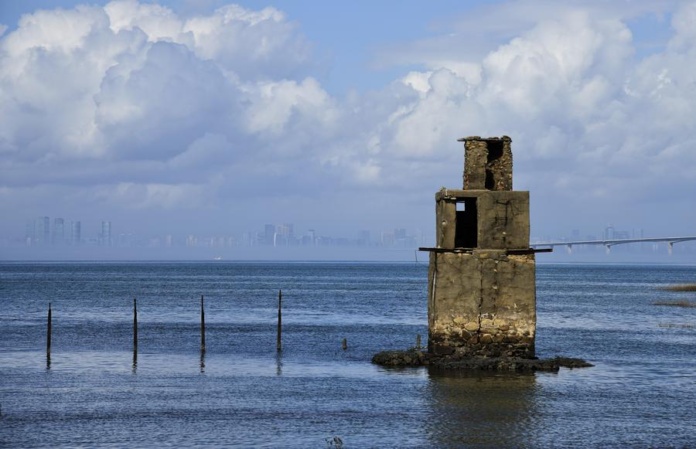Recent developments have revealed how the Mainland Red Cross, the Strait Exchange Foundation from Taiwan, and the Taiwan Mainland Affairs Council have been dealing with the aftermath of a mainland boat’s tragedy, which led to the deaths of two mainland fishermen off the coast of Kinmen on February 14. The politics involved in such communications will be analysed in this article.

On February 16, the Taiwan side’s Strait Exchange Foundation (SEF) – a semi-official organization set up by the Taiwan government to deal with technical and business matters with the mainland – wrote a letter to the mainland’s Association for Relations Across the Taiwan Straits (ARATS) and arranged the relatives of the mainland fishermen to go to Kinmen to handle the matters concerned.
On February 17, the spokesperson of the mainland’s State Council Taiwan Affairs Office, Zhu Fenglin, said that, from the ancient times, there have been no “prohibited waters” around Kinmen, and as such, the Taiwan side had to shoulder the responsibility of the deaths of the two mainland fishermen. At the same time, the Fujian marine police remarked that it will enhance its ability to implement law and order on the waters to protect the order and to safeguard the lives and properties of the mainland fishermen.
Zhu also remarked that the incident involving the deaths of the two mainland fishermen was “malicious.” In response to Zhu’s remarks, the Taiwan side’s Mainland Affairs Council said that the mainland fishing vessels “cannot” enter the “restricted Taiwan waters, and that the Taiwan marine inspection vessels needed to protect the “normal order on Taiwan waters.”
On February 18, Zhu Fenglin commented that the mainland marine police would take inspection action on the waters of Xiamen and Kinmen as a part of normalization – an action that would be resolutely supported by the Taiwan Affairs Office. Her remarks meant that there will be action taken by the mainland marine police to patrol on the waters of Xiamen and Kinmen.
On February 19, four marine police vessels from mainland China were appearing in the waters of Xiamen and Kinmen, and they surrounded the northern, southern, and southeastern parts of Kinmen. On the same day, the spokesperson of the mainland Taiwan Affairs Office, Zhu Fenglin, repeated that after the incident of “Taiwan side rudely treating the mainland fishermen,” the mainland side decided to send the Quanzhou Red Cross to accompany the family members of the victims to go to Kinmen. Zhu remarked that the Taiwan side should facilitate and arrange the mainlanders’ visit for the sake of “avoiding further harm to the sentiments of the comrades of the two straits.”
On the same day, the Kinmen Fishing Association made a declaration: (1) due to the sensitivity in cross-strait relations, Taiwan’s fishermen should not cross the boundaries to engage in illegal fishing while protecting their own personal safety; (2) if the Taiwan fishermen encounter any marine dispute or any sudden inspection by the mainland official vessels, then they can call the Taiwan Fishing Association or the Taiwan Marine Inspection authorities.
The Taiwan Defence Ministry simultaneously announced on February 19 that within the 24 hours, there were seven airplanes from the People’s Liberation Army (PLA) flying near the Taiwan airspace, while seven mainland PLA warships had movements. Objectively speaking, the sudden announcement seemed to make the cross-strait atmosphere tense, but perhaps the movement of mainland fighter airplanes and warships was coincidental.
On February 19, a Taiwan ferry running across Kinmen and Xiamen suddenly saw mainland marine police boarding the ferry and conducting inspection. On the next day, Taiwan news reported that mainland marine police vessels again went into “Kinmen waters.”
The action of the mainland marine police in conducting inspection on the Taiwan ferry on February 19 fit into what Zhu Fenglin mentioned on February 18 that mainland marine police would take inspection action as a sort of “normalization” activities.
In response, the Taiwan Mainland Affairs Council criticized such mainland marine police’s activity for “hurting the sentiment of the people from two sides.” The Taiwan Transport Department and Marine Port Bureau publicly said that, if Taiwan vessels meet mainland marine police’s inspection action, they could refuse stopping their vessels and should return to Taiwan quickly – an announcement that led to criticisms from some Taiwan commentators, who believed that the Taiwan government “kicked the ball” to the Taiwan citizens to solve the problems rather than taking action to tackle the issue itself.
Although the Taiwan transport and marine authorities might make public remarks that were not conducive to the resolution of cross-strait relations over the “prohibited” waters, the Taiwan Defence Ministry said that it would not intervene in such mainland marine police’s inspections of Taiwan vessels – a wise move that defused any crisis and prevented any unnecessary escalation of tensions across the two straits.
On February 20, Quanzhou Red Cross adviser Li Chaohui led six relatives of the mainland fishermen to visit and arrive Kinmen. Li said that their visit aimed at “comprehending the facts, helping the relatives of the victims to manage post-death matters, and bringing back two survivors to the mainland.”
Li also brought his colleagues from the Quanzhou Red Cross and a mainland lawyer to visit Kinmen. He added that the Taiwan side should not object to the mainland delegation’s basic request of finding out the facts of why two mainland fishermen died.
On February 20, two survived mainland fishermen were arranged to return to the mainland from Kinmen. However, when the Mainland Affairs Council staff showed a document to request the Mainland Red Cross to sign on it as an affirmation of “repatriating mainland personnel,” the mainland side refused to do so. In response, the Taiwan Marine Inspection authorities said that the mainlanders would still be sent back to the mainland even though the mainland Red Cross refused to sign the document concerned.
On February 21, the mainland survivors returned to Xiamen, and they complained that the Taiwan side treated them “cruelly,” and that the Taiwan Marine Inspection vessel actually clashed with the mainland boat on the afternoon of February 14. In response to the remarks of the mainland surviving fishermen, Zhu Fenglin said that the mainland side called for the Taiwan side to reveal the facts, penalize any persons responsible for the incident, and explain the situation to the victims of the mainland fishermen.
At the same time, the Taiwan news reports revealed that the Taiwan Marine Inspection vessel did not carry any video camera when it chased the mainland fishing boat on February 14 – a situation confirmed by the Kinmen prosecution department. Although an officer on the Taiwan Marine Inspection vessel reportedly held a video-camera, his balance was affected by the vessel’s fast movement and by the tragedy that occurred in a short duration of five minutes. As such, there were difficulties in collecting the evidence of the incident. Such explanation naturally aroused criticisms, both from the mainland and Taiwan.
What complicated the matter was that the Taiwan Marine Inspection admitted that there were clashes between the Taiwan Marine Inspection vessel and the mainland fishing boat.
On the night of February 21, Zhu Fenglin from the mainland’s Taiwan Affairs Office said that the Taiwan side should not hide the facts and that it should reveal the facts, penalize the persons responsible for the deaths of the mainland fishermen, handle the requests of the family members of the two mainland victims, and apologize to the family members of the victims.
On February 22, the Taiwan Marine Inspection held a press conference, explaining to the media that the inspection vessel CP1051 belonged to a small one under ten tons, meaning that the vessel did not need to have video-camera in accordance with the law and regulations. However, to avoid similar events in the future, such vessel type will be installed with video-cameras in the future. The department’s explanation was quite defensive, and it could not deal with the criticisms that its CP1051 vessel clashed with the mainland fishing boat.
The way in which the official Taiwan authorities managed the video cameras was criticized by the opposition Kuomintang (KMT). One KMT member and legislator, Chen Yu-jen, said that the Taiwan marine officers were equipped with cameras, but since some of the cameras were made in mainland China, these cameras were not used.
It is not clear that, from all the news reports, on whether any individual officer on CP1051 carried a video camera that could capture the “clashes” between the Taiwan marine inspection vessel and the mainland fishing boat.
However, from the communications between the two sides, the tragedy remains politically significant.
First, both sides rely on the Red Cross to communicate with each other. On February 23, the mainland Red Cross at Jinjiang city led a delegation to visit Kinmen again to have closed-door discussions with the Taiwan side. The family members of the two mainland victims requested an apology from the Taiwan Marine Inspection, but both sides had no consensus. Although both sides had disagreement, what is most interesting in this event is that both sides, including the Red Cross from the mainland and Taiwan, agree to disagree. As such, mutual communications are pragmatic moves at the operational level, regardless of political differences at the higher level.
The mutual communications between the Red Cross of the two sides could be traced back to September 12, 1990, when both sides discussed in Kinmen on how to oversee the transfer of criminal suspects from Taiwan and the mainland. Their discussions led to the Kinmen agreement by adopting the principle of “looking at the facts positively, constructing mutual trust, laying down disputes, and striving for a win-win situation.” This principle has been interestingly revived since the mainland boat tragedy on February 14 – a positive and healthy sign in cross-strait relations even though the ruling parties from both sides are at loggerheads at the level of high politics. But at the level of low politics and practical tragedy, both sides must sit down at least unofficially or semi-officially to communicate over a satisfactory solution to all stakeholders.
Second, the communications between the Taiwan SEF and the mainland’s ARATS – the former writing a letter to the latter, and then the exchange between the Red Cross from both sides — triggered discussions. The letter written by the SEF to ARATS was significant as both sides dealt with pragmatic issues at the operational level.
Third, judging from the personnel participating in the talks in Kinmen, the mainland delegation had members with semi-official status, namely Li Chaohui who is also the director of the Taiwan-Hong Kong-Macau Office in Quanzhou city. If the Red Cross is under the political leadership and supervision of the mainland government, its leading officials, like Jinjiang Red Cross secretary Chao Yongshan, appeared to have semi-official status. The meeting between the two sides on February 23 was politically significant, because the Taiwan side embraced officials from the Marine Inspection, Mainland Affairs Council and the SEF (see Liberty Times, February 24, 2024, in 海巡與中方代表 閉門會談無共識 – 政治 – 自由時報電子報 (ltn.com.tw)). As such, it can be said that the meeting in Kinmen on February 23 has been unprecedented since the deterioration of the cross-strait relations after the assumption of office of Tsai Ing-wen as Taiwan president in May 2016.
In conclusion, the most important unintended and political consequence of the mainland boat’s tragedy off the coast of Kinmen on February 14 is to trigger the discussions between the two sides – both mainland and Taiwan – at the pragmatic and operational level in the interest of the mainland survivors and victims. While the Red Cross from both sides have been involved in mutual communications and dialogues, the semi-official and official authorities from both sides have also been involved in varying degrees, including the mainland side which involve semi-official organizations and personnel with semi-official capacity. On the other hand, the Taiwan side has actually involved the semi-official Strait Exchange Foundation and the official authorities from the Marine Inspection and Mainland Affairs Council. Both sides have demonstrated a high degree of pragmatism, tolerance, and willingness to discuss amid the difficulties of reaching a consensus. If so, cross-strait relations remain cautiously optimistic. We will have to observe how both sides will reach a resolution satisfactory to the family members of the mainland victims in the coming days and weeks.
*Sonny Shiu-Hing Lo is a political scientist, veteran commentator, and author of dozens of books and academic articles on Hong Kong, Macau, and Greater China




















